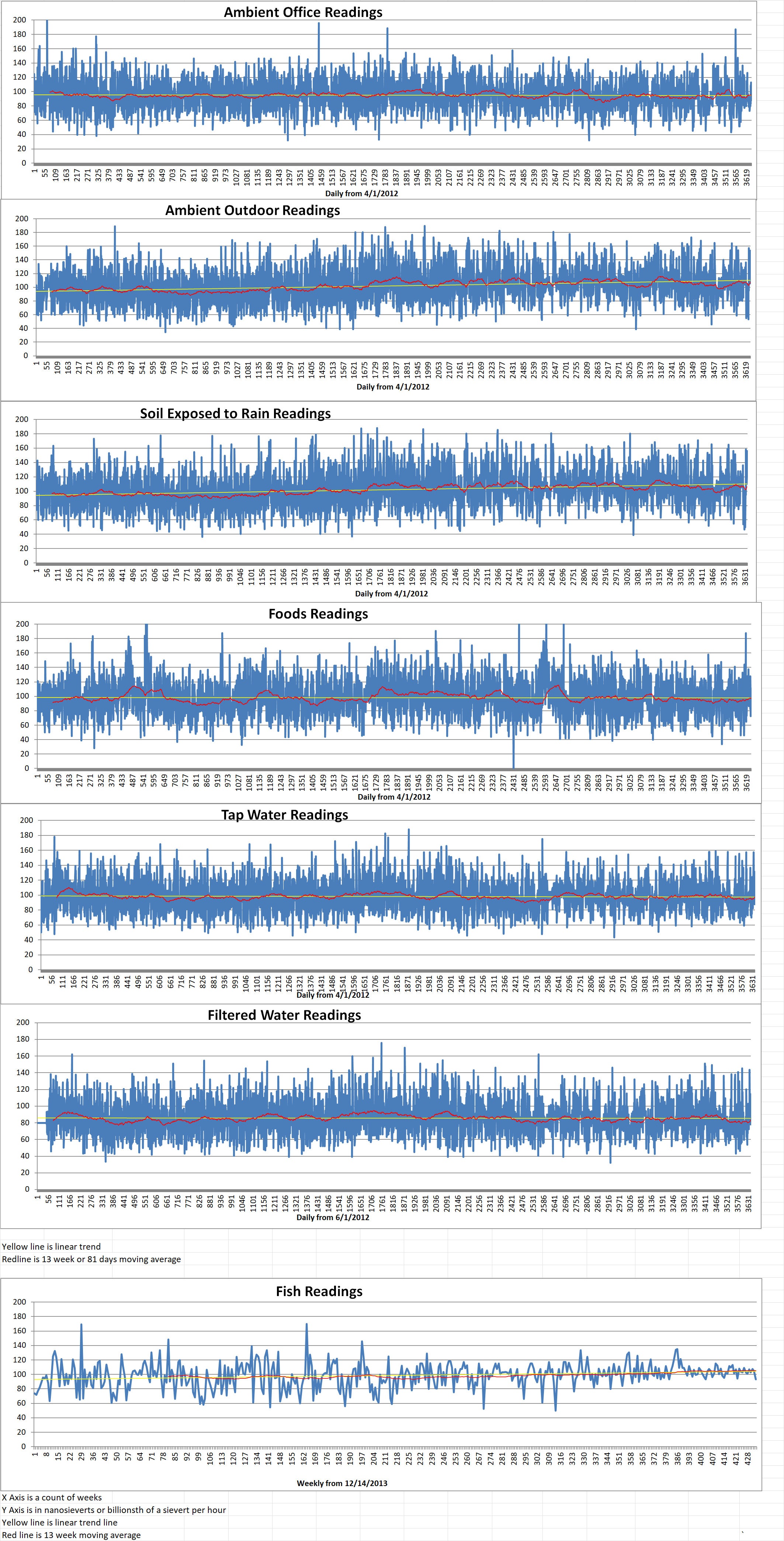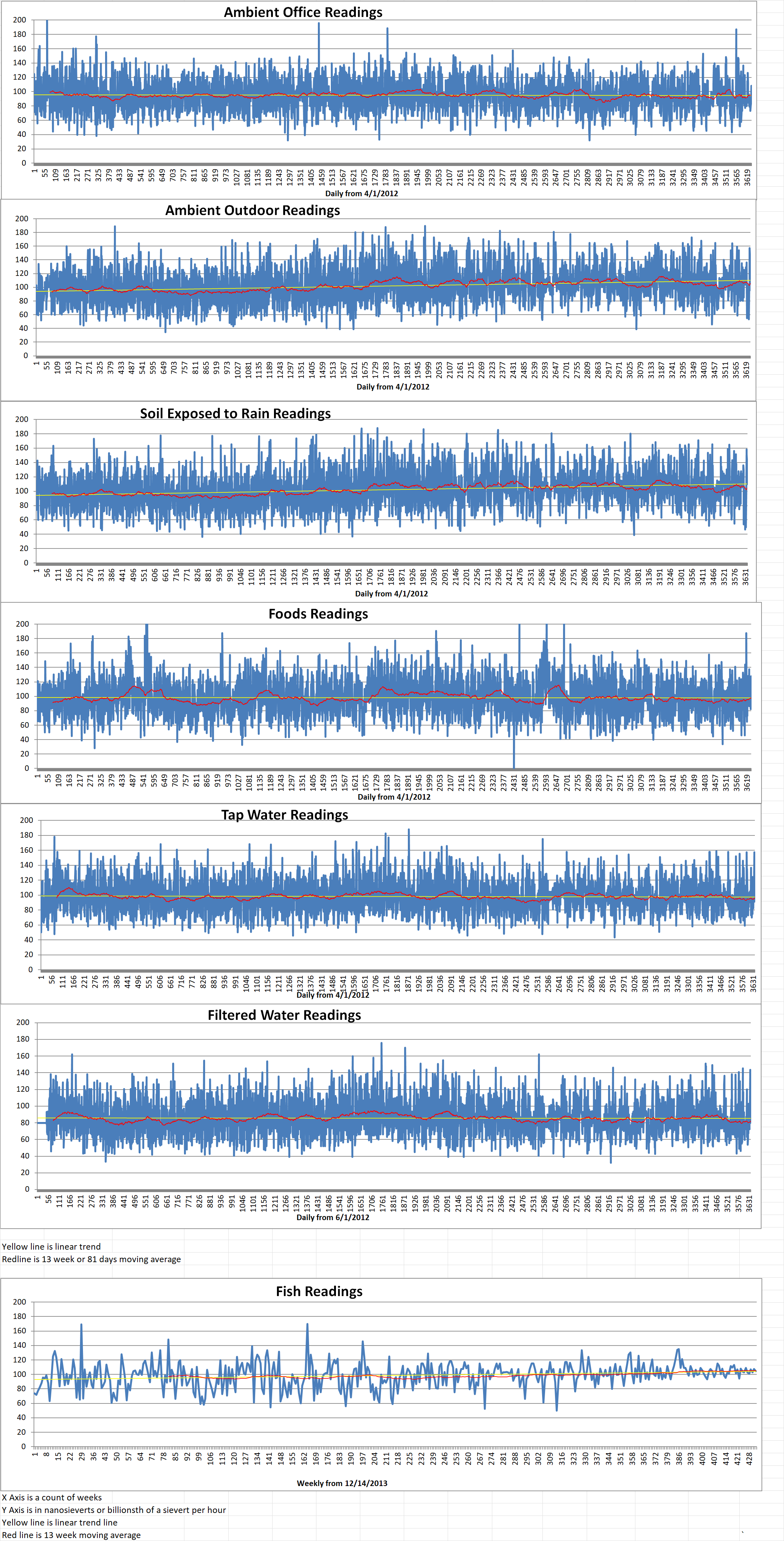Blog
-

Geiger Readings for June 20, 2022
Ambient office = 88 nanosieverts per hour
Ambient outside = 127 nanosieverts per hour
Soil exposed to rain water = 129 nanosieverts per hour
English cucumber from Central Market = 879 nanosieverts per hour
Tap water = 88 nanosieverts per hour
Filter water = 78 nanosieverts per hour
-
Nuclear News Roundup June 19, 2022
Bulgaria’s only nuclear power plant shuts down after generator malfunctions English.alarabiya.net
Russian colonel who carried Putin’s nuclear codes briefcase found shot metro.co.uk
Putin says Sarmat ballistic missile to be deployed by end of 2022 aljazeera.com
BNS questions limit to extended operation of Belgian units world-nuclear-news.org
-

Geiger Readings for June 19, 2022
Ambient office = 113 nanosieverts per hour
Ambient outside = 153 nanosieverts per hour
Soil exposed to rain water = 156 nanosieverts per hour
Blueberry from Central Market = 111 nanosieverts per hour
Tap water = 131 nanosieverts per hour
Filter water = 114 nanosieverts per hour
-
Nuclear News Roundup June 18, 2022
U.S. warship fires flare to ward off Iranian military boat in “unsafe” encounter amid soaring nuclear tension cbsnews.com
South Korean Prez pledges to rebuild nuclear power industry energy.economictimes.indiatimes.com
Nuclear powers and Canada should engage with cause of nuclear prohibition utoronto.ca
Russian Foreign Ministry Says Preventing Nuclear Conflict Priority For Russia ukranews.com
-

Geiger Readings for June 18, 2022
Ambient office = 111 nanosieverts per hour
Ambient outside = 123 nanosieverts per hour
Soil exposed to rain water = 125 nanosieverts per hour
Avocado from Central Market = 72 nanosieverts per hour
Tap water = 89 nanosieverts per hour
Filter water = 80 nanosieverts per hour
Dover Sole from Central = 93 nanosieverts per hour
-

Nuclear Reactors 1041- Several Companies Are Working On Nuclear Powered Floating Desalination Plants – Part 2 of 2 Parts
Part 2 of 2 Parts (Please read Part 1 first)
Kyle Hopkins is the Chief Administrative Officer of Oisann Engineering. He said, “[The technology] was never commercialized because you still need subsea pumps to facilitate taking the water to the surface. We removed the pump.” He has declined to elaborate how the OE system works except for saying that their system takes advantage of the higher pressures on the seafloor to move water around which requires much less energy. He also mentioned that the pipeline from the vessel to shore could be raised so that gravity can assist the flow of water saving even more energy. Mr. Hopkins estimates that the technology could be roughly thirty percent more energy efficient than a conventional onshore desalination facility. OE is currently building a small prototype and hopes to install a commercial version in the Philippines in 2023.
The desalination systems of Core Power and Oisann Engineering are promising says Raya Al-Dadah who is the head of the Sustainable Energy Technology Laboratory at the University of Birmingham. However, floating desalination has both advantages and disadvantages. There are still challenges with respect to pumping the desalinated water ashore. There is also the problem of finding a workforce that has experience in offshore work and desalination.
Ultimately, Dr. Al-Dadah says that humanity needs more water resources. Climate change will be a major problem if the world temperature rises more than four and a half degrees Fahrenheit. “This will have a catastrophic impact on water.”
Amy Childress is on the faculty of the University of Southern California. She says that smaller, floating desalination systems could assist in reducing the environmental impact of the technology. The highly salty brine left after desalination is toxic to marine life. Today’s desalination facilities generate huge amounts of brine. As a matter of fact, they put out more brine than fresh water. Mr. Hopkins states that the byproduct expected from the Waterfountain system will not contain enough salt to be classified as brine.
Greg Pierce is the co-director of the University of California Los Angeles’ Luskin Center for Innovation. He said, with respect to current disaster relief, “we’re flying and trucking-in bottled water… it’s the most inefficient thing possible. If floating desalination can address that, I’m all for that.”
However, Dr. Pierce raises the question of whether desalinization can be made cost-effective enough in other contexts. He notes that there are many other ways of securing clean water supplies. In California, Dr. Pierce estimates better water conservation measures could result in the conservation of thirty to forty percent of the water that is currently consumed in California.
Communities will likely also adopt measures such as water recycling or treatment of rainwater. However, if this is still not sufficient to make up the shortfall in fresh water, desalination begins to look like a high probability in some parts of the world even at a high cost.
For now, Core Power’s design is just a design. However, Mr. Bøe has hopes that, inside of a decade, the company could have a commercial system in operation. The need will still be there. -
Nuclear News Roundup June 17, 2022
Rep. Rob Wittman on US Navy ship retirements and a sea-launched nuclear weapon defensenews.com
PULSAR project to research nuclear technology for Europe’s space missions world-nuclear-news.org
Eliminate nuclear weapons before they eliminate us: UN chief news.un.org
Pope Francis: Nuclear weapons are ‘immoral’ catholicnewsagency.com
-

Geiger Readings for June 17, 2022
Ambient office = 108 nanosieverts per hour
Ambient outside = 106 nanosieverts per hour
Soil exposed to rain water = 110 nanosieverts per hour
Rambutan from Central Market = 87 nanosieverts per hour
Tap water = 113 nanosieverts per hour
Filter water = 98 nanosieverts per hour
-

Nuclear Reactors 1040 – Several Companies Are Working On Nuclear Powered Floating Desalination Plants – Part 1 of 2 Parts
Part 1 of 2 Parts
There is a shortage of potable water around the globe. Hundreds of million people are at risk. Only about two and a half percent of the water on Earth is fresh. Demand for drinking water is estimated to exceed supply by trillions of cubic yards by 2030. Desalinization plants which remove the salt from seawater could help supply the fresh water that is desperately needed.
However, desalinization plants are among the most expensive ways of creating drinking water. They pump huge volumes of water across membranes at high pressure which is extremely energy intensive.
One radical solution could be the use of barges containing desalination systems. Powered by nuclear reactors, these barges could travel to islands or coastlines struck by drought or natural disasters to supply them with drinking water and energy. Mikal Bøe is the chief executive of Core Power. He said, “You could have them moving around on an intermittent basis, filling up tanks.”
This may sound like a fantasy, but the U.S. Navy has supplied desalination services in the past with the help of its nuclear-powered ships. Russia already has a floating nuclear power station that was designed to power desalination facilities.
There are about twenty thousand desalination plants around the world. Almost all of them are onshore. The majority are located in Saudi Arabia, the United Arab Emirates and Kuwait. Desalination plants are located in the U.K., China, the U.S., Brazil, South Africa, Australia, and other countries. Some engineers claim that it might be cheaper to position desalination technology offshore because the seawater can be more easily pumped aboard.
For decades, engineers have imagined floating nuclear powered desalination systems. Core Power intends to use vessels like small container ships, but stack containers on board filled with desalination technology. A nuclear reactor onboard the vessels would supply the huge amount of power required.
Core Power’s floating nuclear desalination vessels could have power level outputs from five to seventy megawatts. A vessel with five megawatts of nuclear power could pump out thirty-five thousand cubic yards of fresh water every day.
In order to remove the salt from seawater, desalination systems pump treated seawater across a semi-permeable membrane at pressure. Osmosis is the movement of molecules in liquid across such membranes. Minerals are removed from water and a separate stream of very salty water called brine is generated. There are a variety of versions of this technology which have become ever more efficient. However, floating desalination systems are relatively rare. Saudi Arabia has just taken delivery of the first of three desalination barges which are the largest ever built.
Oisann Engineering has developed a desalination system called Waterfountain which they hope to sell to the expanding market for desalination. The company has various designs ranging from large ships to small buoys which all operate on the same principle. However, instead of using nuclear power, the OE desalination system utilize what is called subsea desalination which has been in use for decades.
Kyle Hopkins is the Chief Administrative Officer of Oisann Engineering. He said, “[The technology] was never commercialized because you still need subsea pumps to facilitate taking the water to the surface. We removed the pump.” He has declined to elaborate how the OE system works except for saying that their system takes advantage of the higher pressures on the seafloor to move water around which requires much less energy. He also mentioned that the pipeline from the vessel to shore could be raised so that gravity can assist the flow of water saving even more energy. Mr. Hopkins estimates that the technology could be roughly thirty percent more energy efficient than a conventional onshore desalination facility. OE is currently building a small prototype and hopes to install a commercial version in the Philippines in 2023.
Please read Part 2 next
